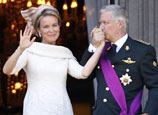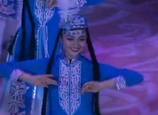
 |
| Artists from Nujiang perform various musical instruments.(Photo/Shanghai Daily) |
The original ethnic peacock dancers are handsome men who strut their stuff and unfold their gorgeous fan tails. Zhang Qian writes about China's diversified ethnic music heritage.
A peacock flutters down to a river bank, observes his own reflection in the water, sips a bit of water, then grooms his feathers and spreads his beautiful tail into an iridescent fan of green, gold and blue.
To the beats of a foot drum (xiang jiao gu 象脚鼓), a small cymbals (nao bo 铙钹) and mang (硭), a kind of gong, 65-year-old Yue Xiang from Yunnan Province portrays a magnificent peacock with graceful movements.
Though most people associate a peacock dance of any kind with the famous female dancer Yang Liping, the indigenous of the Dai ethnic peacock dance was originally a courtship dance by the more beautiful male peacock, which has a fan, not the more ordinary-looking female peahen, which is more drab and does not have the same spectacular plumage.
This male peacock dance was inscribed on China's first list of National Intangible Cultural Heritage in 2006.
Dancer Yue, the 65-year-old "Peacock Dance King" in Yunnan, is himself a preserver of the dance legacy. From July 11 to 17, he performed in a show of international indigenous music for the 42nd International Council for Traditional Music hosted by Shanghai Conservatory of Music.
More than 600 experts in traditional music and dance from more than 56 countries and regions attended, discussing preservation of traditional music worldwide; efforts in China were a major topic.
The International Council for Traditional Music is an NGO founded in 1947 in formal consultative relations with UNESCO. It aims to promote study, performance, preservation and documentation of traditional folk music, as well as dance from all countries. It organizes world conferences, study groups and meetings.
The council's meeting in Shanghai this month was the first-ever session here; it had convened in Fujian Province in 2004 and in Hong Kong in 1991.
China has 56 ethnic groups and a rich and diverse traditional musical culture. Yunnan Province, in the country's southwest, is a region with the most minority groups - 25.
Yang Yandi, vice president of the Shanghai Conservatory of Music, says the music is precious because it's closely related to the daily life, cultures and the natural environment in which it was born.
"To a degree, it was naturally born with people's lives, rather than intentionally composed as an art form," Yang says. "It is unique and irreplaceable to the regional culture, just as genes are to a human being. For example, you never see peacock dance in costal regions where there are hardly any peacock."
Indigenous dance
Worship of the peacock, an auspicious symbol, is said to be the origin of the peacock dance among Dai people, according to peacock dancer Yue. Watching and intimating the elegant movements of peacocks in the forest is the way the Dai dancers create the art.
The indigenous peacock dance can be performed in solos or groups. There are set moves such as looking out from the forest, walking in the woods, drinking and playing on the riverbank and playing chasing games in the woods. Some dancers emphasize imitating the birds' movements, some focus on what the bird may be thinking, and others create dances based on legends.
The Dai peacock dance is traditionally performed only by men, since only the male peacock possesses the gorgeous tail fan.
It was presented at almost every major festival, including the Water Splashing Festival and some Buddhist activities. Many traditions have been lost as the Dai move to cities, adopt modern lives and lose touch with tradition.
The dance that once every Dai person could perform is no longer popular. A few peacock masters such Yue offer low-cost dance lessons, the indigenous dance just doesn't appeal to young people who want to get out of rural areas as soon as they can and make a better life for themselves in cities.
The same is true for many other traditional ethnic music and dance forms in Yunnan Province, according to 30-year-old Li Huaifu, deputy director of the Intangible Cultural Heritage Inheritance Center attached to the Kunming Vocational Academy of Art, established in 2001 to preserve and promote traditional arts in Yunnan.
Li is also passing down hai cai qiang (海菜腔), an indigenous song created by ancestors of the Yi ethnic group as they picked aquatic plants in lakes. According to him, traditional music was on the verge of extinction in his hometown before he and his sisters joined a national CCTV singing gala competition in 2004.
"Hai cai qiang was once a popular regional singing style with a history of around 700 years in my hometown, but only a few old artists could sign a few stanzas before 2004," says Li.
The impact of modern civilization and the low pay for traditional singers are the two major reasons for decline in an area where many people used to be able to sing and dance.
"Visitors to ethnic towns in Yunnan always find young people wearing T-shirts, while they dance, and speaking Mandarin," says Li. "They may be more familiar with karaoke than singing in antiphonal style. It's inevitable in the modern world."
Before 2004, Li and his sisters were earning only 20 yuan (US$3.27) a month through traditional dancing at the Intangible Cultural Heritage Inheritance Center.
"You cannot convince young people that you should carry on the tradition simply because it is precious but with no promising-future attached," says Li.
Cultural lessons
But the work became more financially appealing after Li and his sister received various performance invitations in China and from foreign countries after their performances were broadcast on television.
The Intangible Cultural Heritage Inheritance Center recruited students aged from 14 to 20 years old, receiving both traditional arts and cultural lessons for free.
Quite a few masters of cultural heritage give lessons at the Intangible Cultural Heritage Inheritance Center, while students may travel to remote villages to learn from masters who are too old to travel.
Certificates are presented after graduation.
Though teacher Li cannot make promises since students have not yet graduated, he is optimistic because of the attention focused on preserving traditional indigenous arts in recent years.
Supportive policies from local and central government also encourage dancers. They may include competitions as well as making traditional folk arts part of standards state curriculums.
How to preserve traditional music and dance in modern, globalized society is a universal topic, says president Yang of the Shanghai Conservatory of Music.
"Should we preserve it in a museum-like way or transfer and combine it with modern life? There isn't a definite answer yet and there won't be a universal answer for everyone," he says.
The National Intangible Cultural Heritage List is a positive movement of China to preserve traditional art in a museum-like way, but it also faces the problem of too much commercialization that damages traditional arts.
"Different methods may work for different arts in different regions and ages. Experts and artists worldwide are making their approaches as though they are crossing a river by feeling the stones," says Yang.
















 Solar halo observed in Beijing and Hebei, N China
Solar halo observed in Beijing and Hebei, N China


![]()
